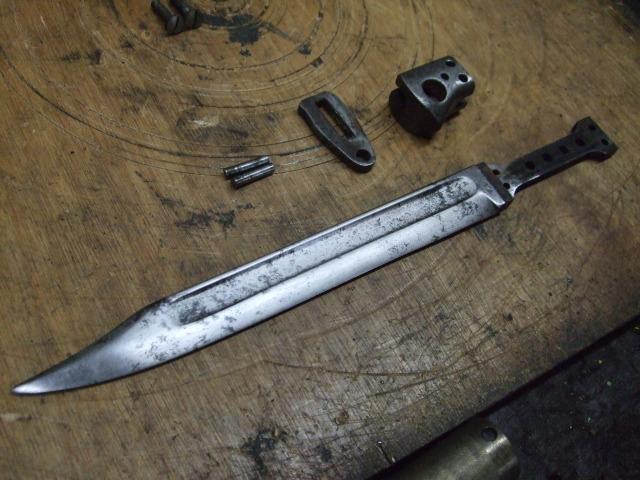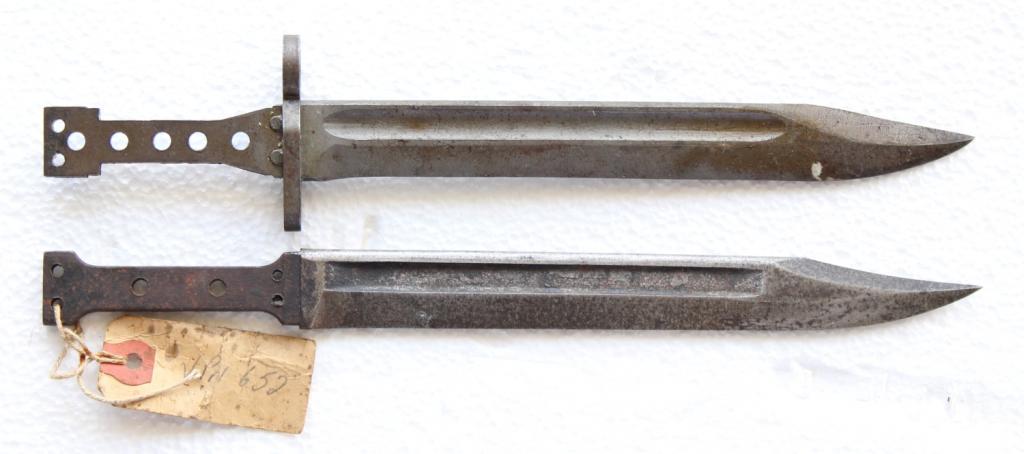-
Sid................. We realise that (thread 8) but the SLR bayonets usually have 5 holes in the tang (one part hidden by the pommell if I remember correctly) which are presumably a reminder of its old No5 rifle/Sterling SMG bayonet ancestry although the geometric spacing is different. And yes, these holes were a part of the design spec. And a manufacturer CANNOT change the design spec without prior testing and approval. Even the change from machined return spring caps and backsight beds to cast return spring caps and backsight beds on the L2A3 had to be trialled and tested. One day I'll tell about a design change that 'changed' that wasn't thought out and eventually caused some head scratching.
-
-
01-03-2014 04:39 PM
# ADS
Friends and Sponsors

-
Legacy Member

Pete, I have never seen a an L1 Series Bayonet with only Two holes in the tang. Like yourself, only the five hole variants. These were 'Lightening' holes to make the weapon lighter. Peter will understand what I am saying. But some of you chaps might understandably think. 'What? a few holes drilled in a bayonet tang. What difference would that make'? This is an understandable conclusion to make. BUT, you MAY have seen some No.4 Enfield Rifle bolt handles with a hole drilled in the base of the 'Ball' of the bolt? This is for exactly the same reason. The Military thinking behind this is simple. If you can lighten as many components as possible, wherever possible. It ALL adds up. If you are a P.B.I (Poor Bloody Infantryman) in the Field. & you have to hump all your own equipment, ammo, water, food, Weapon, Etc, Etc. You WOULD appreciate a lack of extra weight to carry, no matter how small. Some infanteer's march for MANY miles. Which is fatiguing indeed! So although it might seem a small saving in weight reduction. It was done where possible. Bren guns also went through 'Shaving' of edges & lightning cuts to the receiver. For the same purpose.
bolt handles with a hole drilled in the base of the 'Ball' of the bolt? This is for exactly the same reason. The Military thinking behind this is simple. If you can lighten as many components as possible, wherever possible. It ALL adds up. If you are a P.B.I (Poor Bloody Infantryman) in the Field. & you have to hump all your own equipment, ammo, water, food, Weapon, Etc, Etc. You WOULD appreciate a lack of extra weight to carry, no matter how small. Some infanteer's march for MANY miles. Which is fatiguing indeed! So although it might seem a small saving in weight reduction. It was done where possible. Bren guns also went through 'Shaving' of edges & lightning cuts to the receiver. For the same purpose.
Also, Peter will concur on this. After you have inspected many thousands of bayonets. You get a 'feel' for spring pressure when withdrawing a bayonet from it's scabbard. During inspection period's when at task on the bench. It soon becomes a skill that you CAN feel if a spring is weak when pulling a blade!
-
Thank You to tankhunter For This Useful Post:
-
Legacy Member

I think there is a simple answer to the question of the number of holes in the tang. Officially and shown on the plans is 5 holes. I think the contractor (AW, whoever they are?) decided to simplify production, which would make it slightly cheaper but quicker to produce and only drilled 2 holes for the grip rivets.
As Peter pointed out this as a no-no for contractors to change the official design without approval first. BUT i some cases during production of parts something can go wrong or a step is missed out, or it doesn't quite conform to the specs. In these cases the parts were checked to see that they conformed functionally and then a CONCESSION was granted and this concession was marked on the component. This was done to inform the Armourers that although the part didn't conform to the specs in the regulations it was approved for use. An example would be the British Laminated handguards. There is a batch of these that have a concession mark because they don't conform to the correct shape. They are allowed, but must be used in matching concession pairs. On larger components the concession number is stamped eg, C20640 stamped on some newly produced Enfield barrels which have pitting on the plated area of the chamber.
Laminated handguards. There is a batch of these that have a concession mark because they don't conform to the correct shape. They are allowed, but must be used in matching concession pairs. On larger components the concession number is stamped eg, C20640 stamped on some newly produced Enfield barrels which have pitting on the plated area of the chamber.
Anyway back to the bayonet......... I think due to a number of factors these AM86 bayonets are official, for the MOD, its possible the manufacturer decided that by the time anyone ever took the grips off an assembled bayonet to would be too late to do anything about it. Or if they had been inspected as components that the MOD was still to sort out the paperwork and issue a Concession and an armourers instruction about the missing holes which didn't affect functionality of L1A4 Bayonet.
But as it was pointed out the L85/L86 were being issued and the fate of the L1A1's was sealed, it was to be relegated to war reserve or scrap. I don't think the pencil pushers were in too much of a rush to get it sorted. The paperwork is probably still sitting somewhere waiting to be officially implemented.
-
-
Never had a SLR bayonet totally stripped but thought this may help, a pic of a stripped No5 bayonet (jungle carbine) to show the holes (only four on these, plus the four rivet holes)

Last edited by bigduke6; 01-11-2014 at 05:21 PM.
-
-
Advisory Panel


Here's the pic from the thread I posted... Attachment 48779
-
Thank You to browningautorifle For This Useful Post:
-
Legacy Member

-
The Following 2 Members Say Thank You to nzl1a1collector For This Useful Post:
-
I just KNEW that I'd counted 5 holes in the drawing...... I remember having all the individual parts and drawings from Enfield while at Warminster and mounting them on a small display board titled 'THE ANATOMY OF A BAYONET---- not as simple as it looks is it'? Some visitors might remember it, next to my office
-
-
Legacy Member

-
-
Advisory Panel



Originally Posted by
sexyfishsticks

Here are the blueprints
I can't see anything...
-
-
Interesting little thread to read again. Brings back some old names. Where are you Big Duke and Kevin the Kiwi?
-
















 PM
PM











